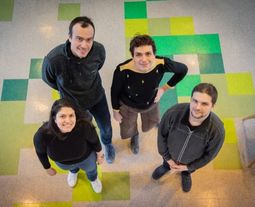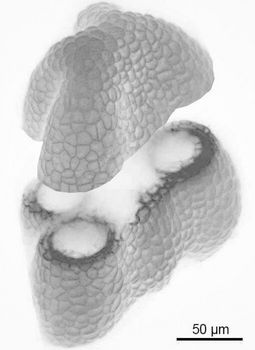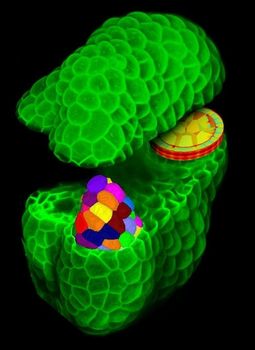
Sylvia Silveira, Daniel Kierzkowski, Anne-Lise Routier-Kierzkowska and Loann Collet
Credit: Amélie Bauer
Plants don't just grow, they build. From towering trees to delicate flowers, complex plant shapes are sculpted with remarkable precision. Now a study by biologists and biophysicists at Université de Montréal reveals how plants build their organs in three dimensions.
Anthers-the male reproductive organs of flowers-are crucial structures responsible for producing and releasing pollen and play a key role in fertilization, a process necessary for fruit and seed production, the scientists say in their paper, published last week in Nature Plants.
It's the first time that scientists have successfully reverse-engineered the physical properties of cells located deep within a plant organ based on experimental data.
These organs hold more than meet the eye.
Led by two associate professors at UdeM, Daniel Kierzkowski and Anne-Lise Routier-Kierzkowska, researchers tracked the growth of every cell in the anther over several days, revealing how the anther started from a simple group of stem cells and developed into a complex 3D structure.
Combining molecular biology and biophysics, the scientists tackled a fundamental question: how can cells communicate across the organ to coordinate their growth and produce complex shapes?
Mechanical forces at work
Plants are built of tiny cells that are surrounded by stiff cell walls, that are organized into tissue layers. The epidermis, the most external layer, is easy to observe with microscopes and is assumed to play a key role in actively controlling growth and development.
In their study, the UdeM scientists challenge this view by demonstrating that inner cells actively shape complex anther form. Using advanced imaging methods, they quantified cellular growth in all tissue layers of the entire complex organ in 3D.
It's a remarkable feat: never before has any plant and animal system been mapped this way in 3D.
The scientists discovered that cells in inner tissue grow much faster than the epidermis, therefore shaping the young organ from the inside out.
"Traditionally, research on plant development focused on the epidermis as the key tissue dictating organ growth," said Kierzkowski, a molecular biologist in UdeM's Department of Biological Sciences.
But our data show that localized, faster expansion of inner cells drives the outgrowth of the anthers by actively pushing outward, stretching the epidermis surrounding them."
"The mechanical force imposed by inner tissues switches the growth patterns of the epidermis and modifies its cell shape," added Routier-Kierzkowska, a biophysicist who holds a Canada Research Chair in Plant Biophysics for Sustainable Agriculture and Climate Resilience.
"This is an example of cellular coordination between tissue layers, via physical forces."
'Encourages a re-examination'
This work underscores the importance of inner tissues during morphogenesis-an aspect often overlooked due to the technical challenges of quantifying growth and mechanical properties below the epidermis, the scientists say.
"Our work encourages a re-examination of other plant organs and animal systems, where internal tissues could play a similar role," said Kierzkowski.
Beyond explaining how the anther gets its shape, this work may have a significant impact in developmental biology, added Routier-Kierzkowska.
"We showed that anatomy - how cells are shaped and arranged - is a key factor in determining the capacity for growth in each tissue layer of the organ," she said. "These different growth capacities lead to mechanical interactions that, in turn, shape the whole organ, as well as individual cells within tissues."
Looking ahead, the team plans to investigate how plants create complex movements - such as the twirling motion of vines, or drilling of roots in the soil - via mechanical interactions between tissues.
"Our work could inspire the design of smart materials and soft robots," said Routier-Kierzkowska. "The possibilities are great. Plants will continue to amaze us in many ways."
About this study
"Mechanical interactions between tissue layers underlie plant morphogenesis," by Sylvia Silveira et al., was published March 26, 2025 in Nature Plants. This research was mainly funded by The New Frontiers in Research Fund, which supports interdisciplinary high-risk / high-reward, transformative Canadian-led research.








